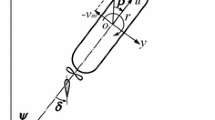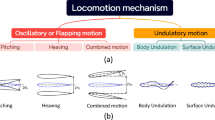Abstract
Meteorological observation by a helicopter was carried out to investigate the structure of sea breezes over the coastal area of Tosa Bay in Shikoku island, Japan. Several groups of wave trains were found over the sea during a flight made on 25 November 1992. Not only the terrain barrier but the remaining cold air pools formed in valleys hindered further advance of the sea breeze inland, so that the presence of such wave trains may appear to be due to the effect of the secondary flow which supplies moister and cooler air from behind the sea breeze front.
Similar content being viewed by others
References
Asai, T. and Mitsumoto, S.: 1978, ‘Effects of an Inclined Land Surface on the Land and Sea Breeze Circulation: A Numerical Experiment’,J. Meteorol. Soc. Japan 56, 559–570.
Atlas, D.: 1960, ‘Rader. Detection of the Sea Breeze’,J. Meteorol. 7, 244–258.
Chiba, O., Kondo, Y and Kawamura, G.: 1993, ‘Characteristics of the Sea Breeze Penetrated into Kochi Prefecture’, (in Japanese),tenki 40, 109–117.
Chiba, O.: 1993, ‘The Turbulent Characteristics in theLowest Part of the Sea Breeze Front in the Atmospheric Surface Layer’,Boundary-Layer Meteorol. 65, 181–195.
Donn, W. L., Milic, P. L. and Brilliant, R.: 1956, ‘Gravity Waves and the Tropical Sea Breeze’,J. Meteorol. 13,356–361.
Fujimoto, A.: 1973, ‘Micro-Meteorology over the Sea Surface: Land and Sea Breeze in Hiroshima Bay (in Japanese),tenki 20, 557–564.
Lenschow, D. H. and Stephens, P. L.: 1980, ‘The Role of Thermals in the Convective Boundary Layer’,Boundary-Layer Meteorol. 19, 509–532.
Linden, P. F. and Simpson, J. E.: 1985, ‘Microburst: A Hazard for Aircraft,Nature 317, 601–602.
Simpson, J. E., Mansfield, D. A. and Milford, J. R.: 1977, ‘Inland Penetration of Sea-Breeze Fronts’,Quart. J. Roy. Meteorol. Soc. 103, 47–76.
Toritani, H., Naito, G., Kobayashi, F., Muraji, N. and Tohmine, K.: 1993, ‘Comparisons of Observational Data using a Helicopter with Radio Sonde Data’, (in Japanese), Submitted totenki.
Uda, M.: 1938, ‘Researches on “Siome” or Current Rip in the Seas and Oceans’,Geophys. Mag. 11, 307–372.
Yanagi, T.: 1987, ‘Classification on “Siome”, Streaks and Fronts’,J. Oceanogr. Soc. Japan 45, 149–158.
Author information
Authors and Affiliations
Rights and permissions
About this article
Cite this article
Chiba, O., Naito, G., Kobayashi, F. et al. Wave trains over the sea due to sea breezes. Boundary-Layer Meteorol 70, 329–340 (1994). https://doi.org/10.1007/BF00713774
Revised:
Issue Date:
DOI: https://doi.org/10.1007/BF00713774




